The lion, the king of the jungle, and its cohorts, fellow large wild cats, have terrified the wild with brute force and enormous size.
Other animals, including the elephant, giraffe, and bear, are famed for their large sizes. However, there is one apex predator we are missing, the wolf, the world’s largest canine, surpassing jackals, coyotes, and various wild dog species.
Despite these canines being undisputedly large, with strong legs, powerful jaws, and incredible hunting skills that put them atop the food chain in many ecosystems, some species and subspecies outclass others within their vast subfamily in size.
The red wolf, Mongolian wolf, and tundra wolf are among the largest wolves in the world, but we have seven more to consider in this article.
Read on to discover these species, their size, and other interesting facts you should know.
The Largest Wolves in the World
10. Mongolian Wolf
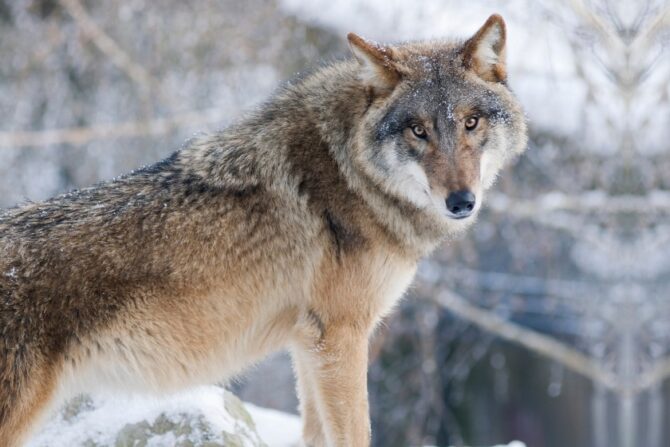
- Scientific Name: Canis lupus chanco
- Height: 1 foot, 11 inches – 2 feet 11 inches
- Weight: 22 – 30 kg
- Length: 3 feet, 6 inches
- Conservation Status: Near Threatened
Mongolia, the world’s eighteenth-largest country, is home to one of the biggest wolves — the Mongolian wolf.
This gray wolf subspecies is notorious for its intimidating size, measuring over three feet long, reaching nearly three feet in height, and weighing about 22-30 kilograms.
The Mongolian, Russian, Chinese, and Korean canine has a dull orange, brownish-yellow, or tawny coat with intermixed gray and black hairs, complemented by pure white fur on the chest, throat, belly, and inside of the legs.
9. Himalayan Wolf

- Scientific Name: Canis lupus chanco
- Height: 2 feet, 6 inches
- Weight: 35 kg
- Length: 3 feet, 7 inches
- Conservation Status: Endangered
The Himalayan wolf is genetically the same as its Tibetan and Mongolian counterparts.
However, it is uniquely characterized by its thick, wooly coat, yellowish-white fur on the face, limbs, and belly, and dull earthy-brown hairs on the back and tail.
The Himalayan wolf is also genetically marked by its tolerance to the low oxygen level at high elevations.
Moreover, this wolf species is larger than its Mongolian cousin, with a few inches in height, about an inch in length, and a few kilograms heavier.
Himalayan wolves are endangered in the Himalayas mountain range, Ladakh, the Tibetan Plateau, and the Central Asian mountains.
8. Red Wolf

- Scientific Name: Canis rufus
- Height: 2 feet, 2 inches
- Weight: 23 – 39 kg
- Length: 4 feet, 5 inches – 5 feet, 3 inches
- Conservation Status: Critically Endangered
The United States’ wolf species, the red wolf, is a large canine, fairly larger than a coyote but smaller than some gray wolf subspecies.
This wolf measures between four and five feet in length but is over two feet tall; however, it may weigh close to forty kilograms.
The red wolf colors are characterized by tawny or grayish coats with light markings around their faces.
They feed on raccoons, white-tailed deer, nutria, and rabbits in northeastern North Carolina, where they were reintroduced in 1987.1
Dive Deeper: Coyote vs. Wolf vs. Fox: Can you spot the Differences?
7. Steppe Wolf (Caspian Sea Wolf)

- Scientific Name: Canis lupus campestris
- Height: 2 feet, 4 inches
- Weight: 35 – 40 kg
- Length: 4 feet
Trailing the large, flat unforested grasslands in south-eastern Europe might be adventurous, but the big, bad, Caspian sea wolf might be lurking around the corner.
The Caspian sea wolf also called the steppe wolf, is an indigene of the Caspian and Caucasus steppes and steppes of the lower European part of the former Soviet Union.
While this wolf is notorious for carrying rabies, it is also intimidating, growing up to four feet long, over two feet tall, and weighing no less than thirty-five kilograms in adulthood.
6. Tundra Wolf
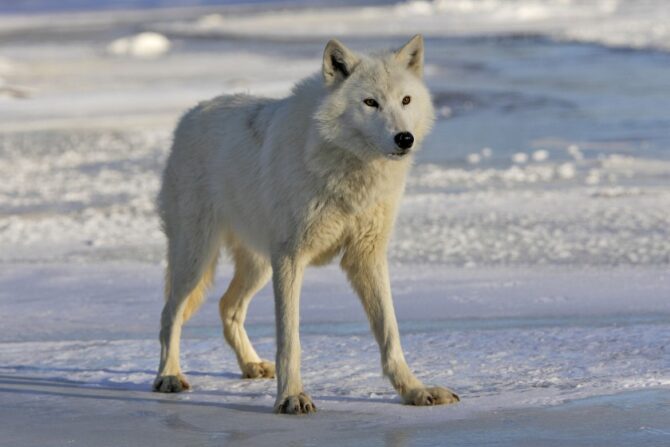
- Scientific Name: Canis lupus albus
- Height: 2 feet, 4 inches – 3 feet, 2 inches
- Weight: 36.6 – 49 kg
- Length: 3 feet, 10 inches – 4 feet, 6 inches
- Conservation Status: Near Threatened
The tundra wolf is a large gray wolf subspecies to Eurasia’s tundra and forest-tundra zones, inhabiting the region’s thickets, river valleys, and forest clearings.
The tundra wolf is characterized by its light gray, long, fluffy, dense, and soft fur.
The Eurasian wolf feeds on hares, arctic foxes, wild and domestic reindeer, birds, and small rodents to reach a full-grown size of almost fifty kilograms, 4.5 feet long, and over three feet tall.
5. Arctic Wolf
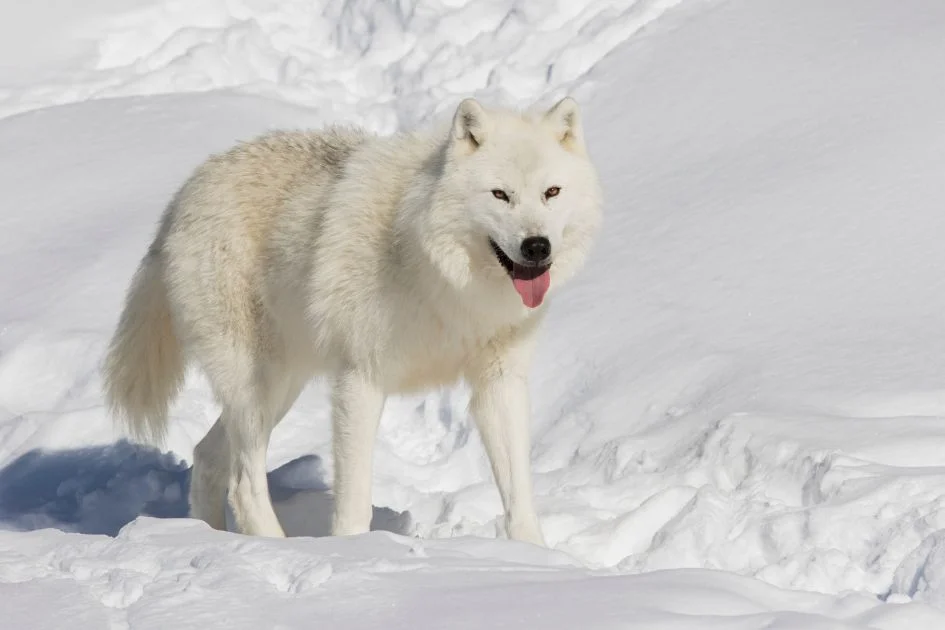
- Scientific Name: Canis lupus arctos
- Height: 3 feet
- Weight: 34 – 46 kg
- Length: 3 feet, 2 inches – 5 feet, 10 inches
- Conservation Status: Least Concern
As the name suggests, the arctic wolf is a wolf species with adaptive modifications and tolerance for colder regions.
The large wolf is indigenous to Canada’s high arctic tundras, solely occupying the northern treeline, unlike similar subspecies that shuffle tundra and forest regions.
Arctic wolf populations also inhabit the glacier regions of Greenland, Alaska, and Iceland.
The arctic wolf might be smaller than its geographical counterpart, the northwestern wolf, but it can grow up to three feet in height, five feet in length, and weigh almost fifty kilograms.
Muskoxen, arctic hares, and caribou have to contend with the arctic wolf’s large appetite, as they serve as prey to satisfy the wolf’s twenty pounds of meat requirement.
4. Northern Rocky Mountain Wolf
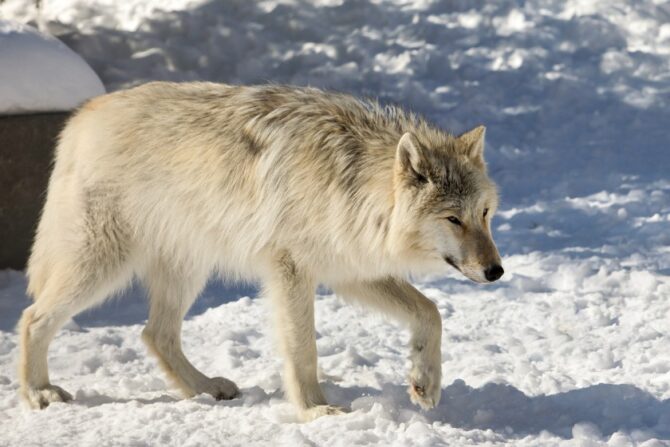
- Scientific Name: Canis lupus irremotus
- Height: 2 feet, 2 inches – 2 feet, 8 inches
- Weight: 32 – 68 kg
- Conservation Status: Secure
The northern Rocky Mountain wolf has a rich history among native Americans, who considered the wolf “sacred.” However, it still holds high esteem today as one of the largest wolves.
The northern Rocky Mountain wolf stands over two feet and can reach sixty-eight kilograms, preying on animals within its range and feeding opportunistically to sustain itself.
The wolf primarily feeds on mule deer, elk, beaver, and bison, daily hunting these animals to consume 10-21% of its body mass.
The northern Rocky Mountain wolf could also be cannibalistic when there is a severe food shortage.
Although the northern Rocky Mountain wolf suffered population decline and extirpation in the Yellowstone region, the conservation status of species is currently secure.2
3. Eurasian Wolf

- Scientific Name: Canis lupus lupus
- Height: 2 feet, 7 inches – 2 feet, 9 inches
- Weight: 69 – 80 kg
- Length: 3 feet, 5 inches – 5 feet, 3 inches
- Conservation Status: Least Concern
The Eurasian wolf also called the common wolf, is endemic to Asia and Europe. While it is popular as one of the most common Old World gray wolves, it also has a reputation for being the largest of the group.
The Eurasian or common wolf averages thirty-nine kilograms but can reach eighty kilograms, standing at over two feet seven inches and growing up to five feet three inches long.
These wolves have relatively short and tawny coarse coats with white markings on the throat and cheeks.
The common wolf has a large appetite, consisting of various prey to sustain its size.
Red deer, moose, roe deer, and wild boar are the most targeted prey, but reindeer, saiga, wild goats, fallow deer, and musk deer also make up the menu.
2. Interior Alaskan Wolf (Yukon Wolf)
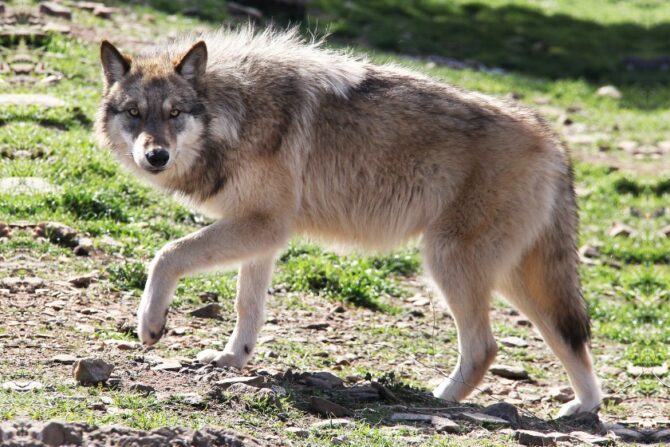
- Scientific Name: Canis lupus pambasileus
- Height: 2 feet, 9 inches
- Weight: 32 – 60 kg
- Length: 4 feet, 11 inches – 6 feet, 5 inches
- Conservation Status: Least Concern
The Interior Alaskan wolf also called the Yukon wolf, is endemic to Alaska and the arctic regions of Canada, including the Yukon, British Columbia, and the Northwest Territories.
It is characterized by its tawny gray or tan coat and large size, averagely weighing 38.5 – 56.3 kilograms.
However, weights could go between thirty-two and sixty kilograms, with reports of an 81.4-kilogram wolf on the record.3
Interior Alaskan wolves do not have a specific diet, as prey varies by region. Still, moose, boreal woodland caribou, barren-ground caribou, and Dall sheep are usual targets.
1. Northwestern Wolf
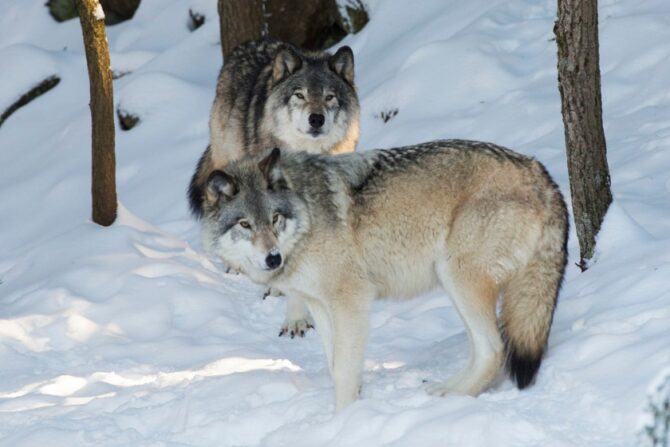
- Scientific Name: Canis lupus occidentalis
- Height: 2 feet, 2 inches – 3 feet
- Weight: 45 – 72 kg
- Length: 5 feet – 7 feet
- Conservation Status: Apparently Secure
Reserving the last for the best, the northwestern wolf surpasses other wolves in size, growing between five and six feet long, but reaching seven feet.
This arctic wolf surpasses seventy kilograms and grows up to three feet tall.
The wolf ranges from Alaska, the northwest United States, the upper Mackenzie River Valley, and western Canadian provinces.
While the Eurasian and Interior Alaskan wolves rival the northwestern wolf in size, the latter is more robust, with a larger head and a thicker muzzle.
It feeds on elk and bison, hunting the youngest or weak members of the herd.
Frequently Asked Questions
What is the largest wolf on record?
The largest wolf on record was a 79.4-kg northwestern wolf documented in 1939 by Frank Glaser, a famous wolf trapper in Alaska. A Eurasian wolf weighed 86 kilograms when it was killed after World War II in the Ukrainian Soviet Socialist Republic.
However, northwestern wolves are famous for their size superiority over Eurasian wolves. Height and length are other metrics considered when evaluating size. Therefore, the 79.4-kg northwestern wolf could have edged considering these factors, making it the largest wolf on record.
Do wolves attack humans?
While wolves are potentially harmful to humans as strong and skillful hunters, they rarely attack humans. Most documented wolf attacks result from pet wolves that have become used to humans. Wild wolves are usually wary of humans and will stay away.
Can you buy a wolf as a pet?
Wolves have a spot in the exotic pet trade, but deciding to get one depends on where you live. Most states and cities forbid citizens from owning a wolf as a pet. While they may allow mixes or wolf-dog hybrids, we advise you to check local laws.
Wrap Up
Wolves are canines with a significance of beauty and controversy. Still, there is no denying that these large, wild dogs have a fearsome presence in the wild.
To give you more perspective on how big these animals can be, here’s a wolf size comparison chart. There are many subspecies, and we have just considered the biggest wolves in the world.
While some of these species are secure and of little conservation concern, others are victims of overhunting and habitat degradation.
We encourage all to support conservation efforts to ensure the continuity of these species.
Next up…
- How To Survive A Wolf Attack In The Wild – Discover effective tips you need to survive an encounter with this vicious predator.
- Can Wolves Climb Trees? How High Can Wolves Jump?
References & Notes
- Red Wolf Recovery Project. U.S. Fish and Wildlife Service Archive.
- Gray Wolf. NatureServe.
- L. David Mech. 1966. Wolves of Isle Royale [Book].






